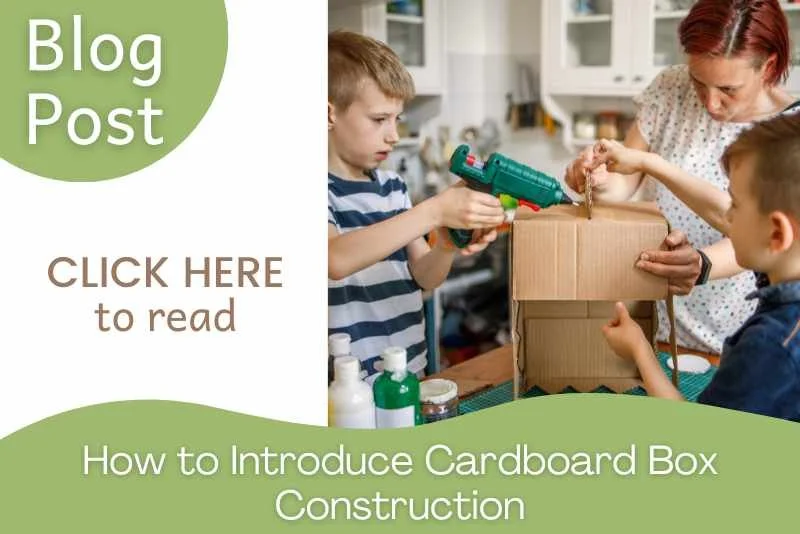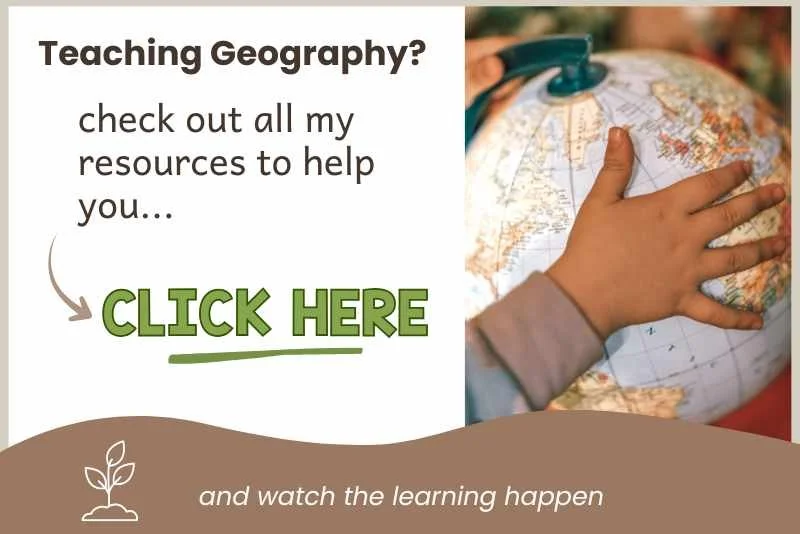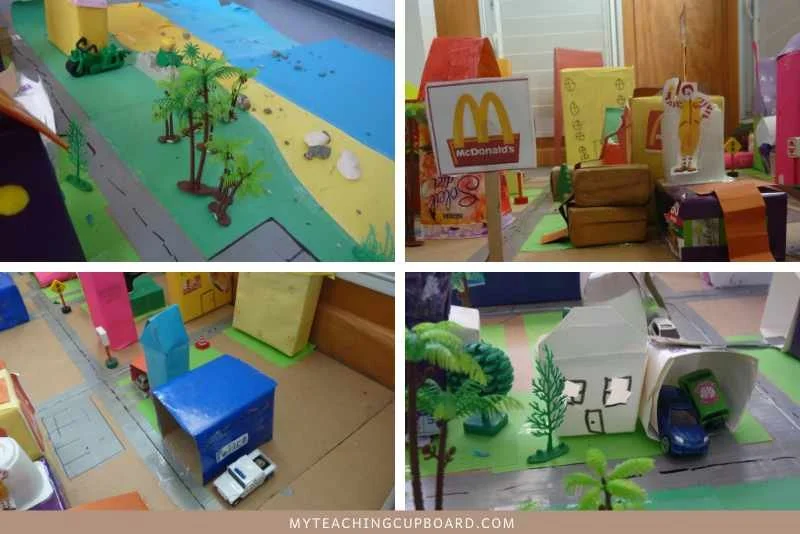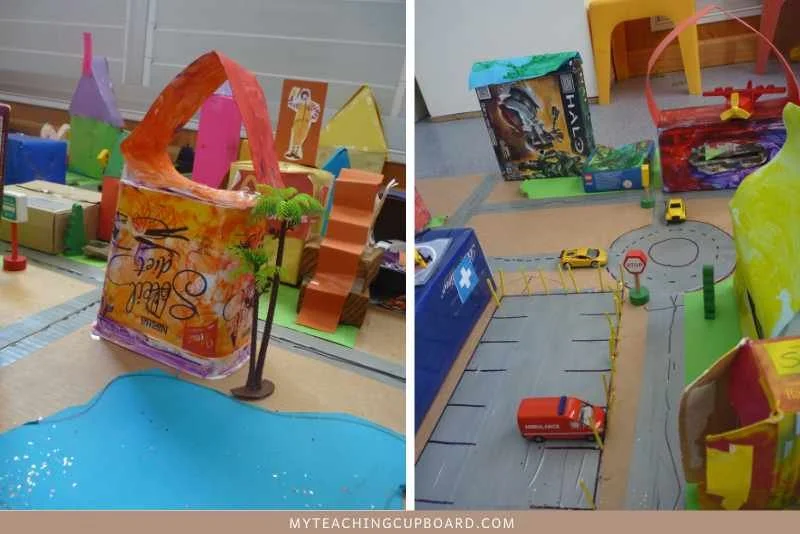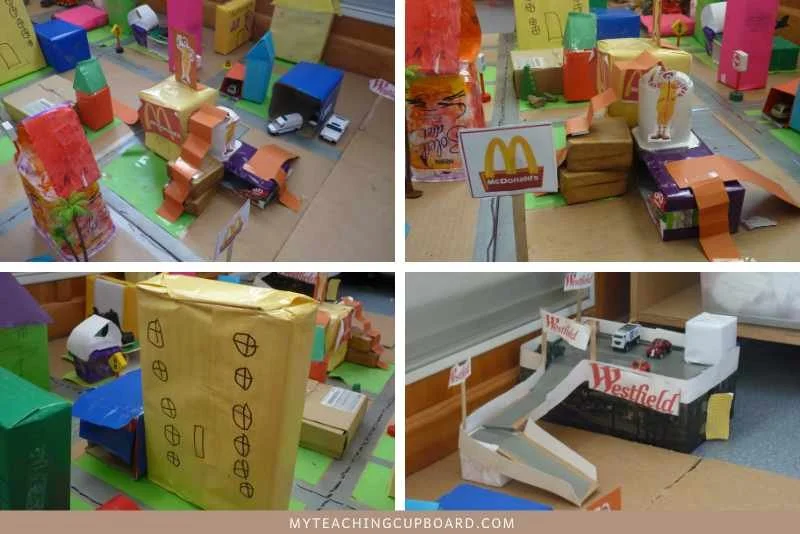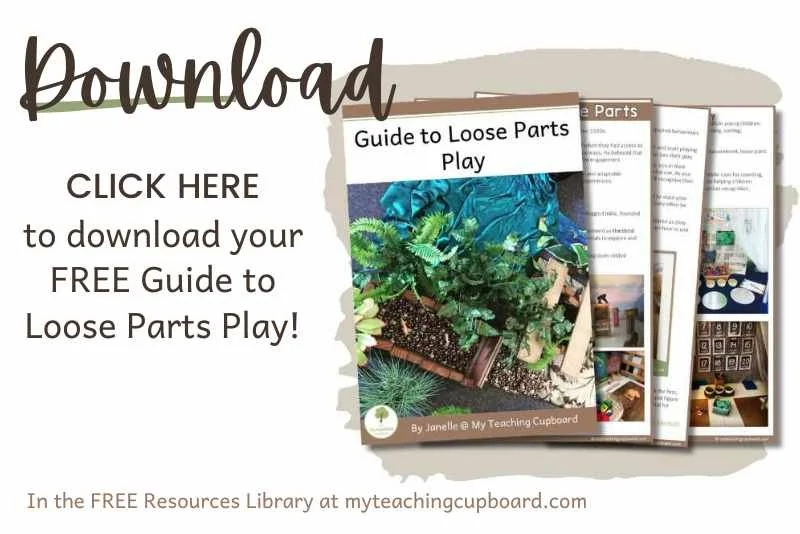Cardboard Box Town
Transform your classroom with a hands-on cardboard box town project! Discover how to teach maths, geography, and problem-solving through creative play using recycled materials.
Why Every Classroom Needs a Cardboard Box Town
It started with just one child, a normal brown box, and a whole lot of imagination.
Within a few days, that single box had grown into something extraordinary - a bustling cardboard box town complete with houses, roads, parks, a hospital with a helipad, a zoo (with a cheeky crocodile escape), and even a McDonald’s with a playground that crossed the street.
But it wasn’t just a fun craft activity! It was a full-blown classroom community project that sparked creative play, collaboration, and deeper thinking in every student in my class.
Each child became completely absorbed in the process.
From taping down grey roads onto a heavy cardboard box base, to constructing buildings out of small boxes and recycled materials, to setting up car parks and pedestrian crossings - it was learning through play at its finest.
One group started a hospital, another suggested a lagoon nearby so patients could look out at something beautiful. Then came the surprise twist: real estate trading! I had to smile when my students debated where they wanted to "live" based on proximity to the beach or the new park.
And just when I thought it couldn’t get any more engaging - a cardboard crocodile turned up in the lagoon!! This lead to the urgent creation of a police station.
Projects like this remind me why I believe so strongly in a play-based pedagogy. They’re a great way to meet curriculum goals while still honouring children’s natural curiosity and creativity AND they are just great fun!
But I also know that as teachers, it can feel like a lot.
You might be wondering:
How do I integrate the curriculum learning intentions in a meaningful, hands-on way?
How do I encourage teamwork, creative thinking, and problem-solving in my class without adding more to my already full plate?
Is there a way to make a good use of all those cardboard boxes and recyclables without it becoming chaos?
The answer?
A cardboard box activity that turns your classroom into a box city. An engaging project that blends art projects, craft projects, and city planning with real-world learning.
In this blog post, I’ll show you how you can build your very own cardboard box town from the ground up using simple, everyday materials like toilet paper rolls, cardboard boxes, and random pieces of cardboard.
You’ll see how this activity connects with Version 9 of the Australian Curriculum in:
Maths (geometry and location)
HASS (community and place)
Technologies (planning and creating)
- all while giving your kindergarten and preschool students (or foundation learners) the opportunity to collaborate, explore, and create.
The Benefits of Box Construction for Kids
There’s a reason why building a cardboard box town has become a much-loved staple during Investigation time in my classroom each year. It’s such a great way to spark engagement while ticking off so many learning outcomes.
What starts as a simple collection of cardboard boxes, small boxes, and recycled materials quickly transforms into a rich and purposeful learning environment that supports almost every area of early childhood development.
Here’s why box construction is worth every minute of your classroom time (and every trip to the recycling bin).
Hands-on Learning that Builds Thinkers
Box construction invites children to explore ideas through doing - experimenting, failing, trying again, and thinking critically. Whether they’re figuring out how to cover a cardboard box, building a box city playground, or working out how tall their hospital should be, the process naturally supports problem-solving and creative play.
Mathematical Thinking in Action
Forget worksheets.
During our cardboard town project, my students were constantly exploring 2D and 3D shapes as they folded and constructed buildings, comparing large boxes to small ones, and using informal units to measure and plan.
Drawing road lines, designing a play scene, and mapping out who lives where all link directly to the geometry and location strand of the Foundation stage Maths curriculum:
AC9MFSP01: sort, name and create familiar shapes; recognise and describe familiar shapes within objects in the environment, giving reasons
AC9MFSP02: describe the position and location of themselves and objects in relation to other people and objects within a familiar space
AC9MFM01: identify and compare attributes of objects and events, including length, capacity, mass and duration, using direct comparisons and communicating reasoning
It’s learning Foundation Stage maths in a way that’s meaningful and memorable.
Fine Motor Skill Development
There’s nothing like using scissors on a stubborn piece of cardboard to build muscle strength and persistence!
Children refine their scissor skills, improve hand-eye coordination, and develop control as they cut, fold, and tape everything from houses to signposts. Even decorating their buildings, drawing doors and windows or adding little flower boxes all requires careful, controlled movements.
Social-Emotional Learning in Real Time
Cardboard towns are a perfect base for building social skills. Students must communicate, collaborate, and negotiate as they design shared spaces like the car parks, decide who gets to live near the cardboard city lagoon, and establish rules, like only being allowed to play in the town if you’ve built a home.
It’s real-world role play with emotional depth: resolving disagreements, compromising on where the zoo should go, and supporting others in their building efforts.
STEM and Engineering Foundations
Constructing a town means exploring how to make things stand, balance, and support weight. It might be a rooftop car park, a slide that crosses the road, or a lift in the Westfield shopping centre. Students are naturally working like engineers as they prototype, redesign, and improve their constructions.
And yes, you’ll absolutely hear phrases like “That roof doesn’t fit!” or “How do we make the lift work?”… followed by some brilliant solutions!
Environmental Awareness and Resourcefulness
One of my favourite parts of this project is that it makes such good use of recycled materials. Children learn that what might normally be thrown away – like toilet paper rolls, cardboard tubes, and bits from the collage table, can become something useful and beautiful.
It supports conversations around sustainability and encourages children to see the creative potential in everyday items.
If Box Construction is new to you but something you would like to introduce in your classroom, check out my related Blog Post: How to Introduce Cardboard Box Construction
I love box construction and so do my students. It is an important play-based learning area in the early childhood classroom. In this area, your preschool and kindergarten children will explore science and math concepts as they take part in constructive play. It’s a win - win!!
Teaching 2D and 3D Shapes & HASS Geography Mapping Skills
One of the biggest benefits of a project like this is how effortlessly it integrates multiple learning areas like Maths, HASS, and even Technologies - without requiring separate, isolated lessons.
Instead of squeezing everything into an already packed timetable, you’re hitting key outcomes through one deeply engaging, real-life context: designing and building a cardboard box town.
You might think children are just cutting and taping cardboard boxes together but they are also making sense of the world around them. This kind of city planning mirrors their own experiences in their local community and opens up meaningful conversations about where we live, what we need, and how towns work.
It's hands-on, purposeful, and full of teachable moments.
Maths Integration in a Box City
This is where geometry, measurement, and spatial awareness really come to life.
2D vs 3D Shapes: As children design and build their homes, shops, and towers, they experiment with 2D shapes like rectangles and squares and convert them into 3D forms like cubes, cylinders, and prisms. That moment when a child realises a cardboard tube is perfect for a tower or a toilet paper roll makes a great flagpole? That’s real-world maths at work.
Measurement: There’s real complexity involved in covering a cardboard box with paper to make a house. Children must measure and cut accurately, often learning the hard way that eyeballing it doesn’t always work! They compare lengths, widths, and surfaces while also improving their fine motor skills at the same time.
Spatial Awareness: Setting up roads, roundabouts, and car parks introduces children to direction, location, and positioning. These are all key parts of the Foundation Maths curriculum. Your students are naturally learning terms like “next to,” “opposite,” and “behind” as they build, move, and adjust their layout.
Geography & Mapping in HASS
When children plan their box town, they’re engaging in early geographical thinking. They become little urban planners, considering what makes a liveable place, how people move around, and where services should be.
Zoning and Infrastructure: Children start to notice patterns: "The hospital should be near the park," or "We need a road that leads to the zoo." They're learning to plan with purpose, not just randomly placing buildings. This links directly to the Foundation HASS curriculum AC9HSFK03: the features of familiar places they belong to, why some places are special and how places can be looked after
Mapping Skills: After their town is set up, we often map it out on paper. This helps them translate 3D space into 2D representation - learning to draw symbols, label buildings, and include a key or legend. It’s a brilliant early introduction to spatial literacy.
Understanding Community: Through discussions and construction, children begin to understand the function of different places in their local area. They will discuss why we need schools, shops, hospitals, police stations, and parks. These conversations tap into AC9HSFS05: share narratives and observations, using sources and terms about the past and places as they reflect on the features of their own community and how people are connected to places.
💡 Teaching Tip: If you want to extend the learning, take a walk around your local area beforehand and talk about what you see. Then encourage your students to bring their ideas back into the classroom to inspire their box city planning.
Materials to Make a Cardboard Box Town
You don’t need fancy supplies or a trip to the art shop to build a brilliant box town. Just a bit of creativity and a good rummage through your classroom and recycling bin will get you started!
Below is a handy list of what you’ll need to get started, broken down into easy categories for quick planning.
Supplies from Your Recycling Bin
This is where you’ll transform everyday recycled materials into roads, buildings, and community spaces. Oh and encourage your kids to bring in donations from home too.
Large packing boxes – Perfect for creating the base of your cardboard city. Open them flat and tape them together to create roads and shared spaces.
Small boxes – Think cereal boxes, shoe boxes, tissue boxes - ideal for houses, shops, and smaller buildings.
Cardboard tubes – Use these for trees, towers, or pillars.
Milk bottle caps and straws – Turn them into wheels, traffic lights, signs, and garden features.
These humble materials are the backbone of your cardboard box activity and a good use of what would otherwise be waste and end up in land fill.
Supplies from Your Collage Table
Here’s where students really get to express their creative art skills and personalise their creations.
Coloured paper and craft sticks – Great for adding roof tiles, garden fences, and signage.
Paints and markers – Let students decorate their homes, add shop names, and create advertising for their McDonald's playground or zoo.
Glue, tape, and scissors – You’ll go through a lot of tape, so stock up! Kids will need plenty of these to assemble their buildings.
Props and Loose Parts for Open-Ended Play
Once your cardboard box town is built, it transforms into a rich play scene and is perfect for role play, storytelling, and imagination.
Toy cars – Create cardboard box cars or use small toy hot wheels type vehicles to explore traffic rules, speed limits, and car parks.
Animal figurines – Populate your zoo or vet clinic.
Loose parts – Add pebbles, wood pieces, buttons, pom poms, and natural objects to enhance sensory and open-ended play.
💡 Teaching Tip: Many of these items can be found cheaply at dollar stores, and they’re reusable for other fun craft activities or creative play ideas later on.
How to Make a Town Out of Cardboard Boxes
Our box town started with some heavy card packing boxes opened out flat. These became the foundation of our town. A project that quickly evolved into one of the most engaging and fun craft activities we’ve done in the classroom.
Here's how to guide your students through the process step by step.
Step 1: Create the Base
Start by laying out your large boxes. Flatten them to create a wide surface. These become the perfect base for your town.
We joined ours using grey plastic packaging tape, which quickly turned into the roads of the town. Children then used permanent markers to draw a dotted line down the centre of each road to define lanes.
Step 2: Think About the Layout
Before construction begins, pause and plan.
Ask your class: What does a real town need?
You’ll hear suggestions like houses, shops, a hospital, schools, a zoo, a McDonald’s, and of course, a park or two. These conversations are a great chance to explore city planning, learning preschool geography concepts, and community design.
Encourage critical thinking: If we build too many roads, will we have space for parks? Where will people park their cardboard box cars?
Let students take the lead here because they’re full of ideas and will surprise you with their logic and creativity.
Step 3: Make Roads for Vehicles
Using more grey tape, continue constructing roads throughout your box city.
Children can:
Draw centre lines with markers to show lanes.
Add roundabouts, car parks, and pedestrian crossings.
Build traffic lights using cardboard tubes or milk bottle caps.
Use this time to open up discussions about road safety, directions, and community roles like police officers and lollipop people. You’ll be amazed at how a cardboard box activity can spark so many conversations about real-world topics in a way that feels natural and relevant.
Step 4: Add Buildings and Parks
Here’s where the fun really takes off.
We had a rule that the children weren't allowed to play in the cardboard box town unless they "lived" there. This rule meant each child had to construct their own house.
Most used small boxes, covering them in paper and adding doors, windows, and other personal touches. Some even tackled roof construction, which led to wonderful conversations about 2D and 3D shapes and plenty of trial and error (plus some brilliant teamwork).
Once their homes were finished, children could "buy" a rectangle of green paper for $5 in play money and decide where to place it. This introduces economic thinking and resource management.
Soon, a beachfront area popped up, and lots of students wanted to live near the beach. But then came the twist - someone suggested building a hospital with a helipad, which led to a nearby park and lagoon, and suddenly beachfront property wasn’t so popular anymore! Houses were sold and traded, and new buildings sprang up daily:
A McDonald's with a playground that crossed the street
A Westfield shopping centre with a rooftop car park
A zoo, a vet clinic, and eventually... a police station, after a crocodile from the zoo turned up in the lagoon!
Every part of the construction was child-driven. It was creative play, role play, maths, and HASS learning all rolled into one meaningful, open-ended project that made every minute of our learning time count.
Decorating Your Cardboard Box Town
Once your cardboard box town is built, it’s time to bring it to life. This stage is where children’s personalities really shine through. It’s all about creative play, storytelling, and making the town feel like their own.
Personalising Houses
Children love making their homes unique.
Some of my kids added windows and doors with scrap paper and markers. Others went further by adding flower pots, chimneys, and even driveways made from strips of grey paper.
It’s an opportunity to reinforce spatial vocabulary, talk about parts of a house, and encourage pride in their own city.
You might see one house with a garden made of toilet paper rolls, another with a carport crafted from a cardboard tube, and a third that’s fully fenced in with craft sticks. Each detail helps build a richer play scene and allows students to demonstrate their creative art skills.
Adding Signage
As shops and services pop up across your box city, encourage children to add signs. This is a great opportunity to build early literacy skills. There’s nothing like writing signs for the hospital, zoo, vet, or McDonald’s to embed some authentic literacy!
In one of our projects, students plastered the town with marketing posters for McDonald’s after we talked about advertising. It was the perfect blend of art project, role play, and real-world learning.
You can also add bus stop signs, road names, and directional arrows. These are all excellent ways to bring in authentic text and environmental print.
Building on Interest
Some of the best ideas in our town came from student suggestions.
When one child decided a police station was needed (after the crocodile escaped from the zoo), we paused to discuss: Where should it go? What should it look like? Who works there? These discussions spark rich language, problem-solving, and planning - and they remind us to be responsive to children’s ideas.
Encouraging your students to think through logistics, like adding a roundabout near a busy zone or building a footpath to the school, helps develop real city planning thinking and gives them ownership over their town.
Encourage Open-Ended Play
Once your town is up and running, don’t pack it away. Instead, let it evolve into a small world and loose parts play area where children can revisit, revise, and reimagine their world.
Add toy cars, animal figurines, people counters, and other loose parts to encourage storytelling, role playing, and continued exploration.
You’ll likely see new stories unfold each day: a lost dog at the vet, a parade near the park, or an emergency at the hospital. This kind of free play builds language, cooperation, and higher-order thinking - and it’s a great use of the time and effort spent on construction.
💡 Want more open-ended play ideas?
Download my Free Guide to Loose Parts Play - it’s full of ideas to inspire and extend hands-on learning like this one.
A Project That Keeps on Giving
Our cardboard box town started with one child and a normal brown box.
It quickly grew into something unforgettable - a collaborative, imaginative, curriculum-rich adventure that ticked all the boxes: maths, geography, fine motor skills, social-emotional learning, and above all, creative play.
What made it so powerful wasn’t just the fun (though there was plenty of that), or the clever use of recycled materials. It was how deeply engaged the children were. They were designing, building, negotiating, and problem-solving - all while covering outcomes from the Foundation stage Maths, HASS, and Technologies curriculum.
And the best part?
This project doesn’t require a big budget or hours of prep. Just a few large boxes, some smaller recycled cardboard boxes, and an openness to follow the children's lead.
It’s a great way to bring your curriculum to life, and trust me - your students will remember it for years to come!!
If you're new to box construction or looking for more ways to set up hands-on, purposeful play areas, don’t forget to head over to this blog post:
👉 How to Introduce Cardboard Box Construction – it’s full of helpful tips, practical ideas, and classroom-tested advice.
💡 And if you’re ready to extend your play-based learning even further, download my Free Guide to Loose Parts Play - it’s packed with ideas to inspire open-ended exploration in your classroom.
This project may start with a piece of cardboard, but it leads to a whole world of learning.




